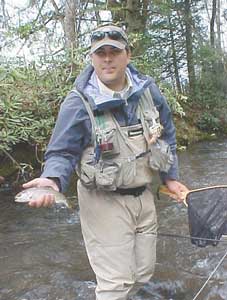
Except when major hatches are coming off, trout feed more often below the surface than they feed on top of the water.To improve your chances of getting a strike any time of the day, use a “dropper.”
Also called a “tag-on” or “trailer,” a dropper is a fly (usually a nymph) tied to the main fly (usually a dry fly).
The dry fly rides on the surface, and the dropper, if it’s a nymph, drags the bottom or is suspended just below the surface. The dropper allows a fisher to fish for trout feeding at the surface, just below the surface, and at the stream bottom without having to switch back and forth between dry flies and nymphs. The dropper technique also eliminates the need for a strike indicator.
Although not widely utilized, the use of droppers is not a new concept.
“Droppers have been used by mountain fishers for a long time,” said Kevin Howell of Davidson River Outfitters near Brevard. “Some of the old-timers would use three or four at a time.”
Some trout fishers tie the dropper onto the tippet, but Howell said the most common technique is to tie the trailing fly on the shank of the main fly, using about 2 feet of tippet. The trailing fly should be at least one or two sizes smaller than the main fly, he said.
“I use a beadhead nymph (usually a No. 14) tied to a larger dry fly (usually a No. 12),” Howell said.
The added weight of the beadhead allows the nymph to sink instead of trailing behind the main fly. Howell also uses a lighter weight tippet for the dropper fly — a 5X or 7X tippet for the main fly and a 6X for the trailing fly.
“If the dropper gets hung up on something, the lighter weight tippet will break off, and you won’t lose both flies,” he said.
If the dropper continually gets tangled on the back cast, use a heavier, stiffer line for the dropper. If you need extra weight to get a dropper to bounce along the bottom, use a nymph with a beadhead or add a couple of wraps of lead on the thorax of the nymph.
An attractor such as a Stimulator, can be used as a main fly, and a smaller size “nymph of the day” as the dropper. The nymph should match the hatch or hatches that are apparent at the time.
The Stimulator, which has a yellow body and orange head, works year-round. It’s easy to see and works well as a strike indicator. It also attracts occasional strikes.
As for the length of the dropper, that depends on what kind of water you’re fishing.
For shallow creeks, use an 8-inch dropper. For big waters like the Tuckasegee, Nantahala or South Toe rivers, use a 2-foot dropper.
When using a dropper, don’t fish straight up a stream. Quarter the stream, casting toward the bank, mending line as the fly washes back, letting the line belly up as it passes. Sometimes, you’ll got a strike right at your feet.
Ronnie Setzer of Franklin, a former guide and long-time trout fisher, said he limits his use of droppers to times when aquatic insects are just beginning to rise, and “you don’t have a lot of dry-fly action.”
Setzer uses the main fly primarily as a strike indicator because “you don’t get a lot of top-water action during this time.”
If the main fly is a strike indicator, Setzer uses a No. 8 Parachute Hopper or a No. 12 Adams. (A parachute fly rides higher on the water and is much easier to see if you have less than perfect eyesight.)
“You might get a strike on the main fly if hatchery fish are in the stream,” he said. “Most times I tie the dropper onto the shank of the main fly’s hook, using 10 to 12 inches of tippet.
The dropper nymph usually is much smaller, anywhere from a No. 18 to 14.
“What I try to do with the dropper,” he said, “is imitate the larvae of any type of insect that’s emerging at the time.”
When he fishes riffles, Setzer said he ties the dropper to the tippet, with the flies trailing in a Y formation.
“That combination is really deadly when you fish fast water,” he said. “It’ll get a strike even in some of the toughest fishing conditions. There’s not really a bad time to use it.”
Setzer said the most effective technique is to strip the fly slowly through the water. As for tippet weight, Setzer said he uses the same size tippet for both the main fly and the dropper when he’s using the dry fly as a strike indicator.
“If I’m fishing the dry fly as an attractor, I use a 5X for the main fly and a lighter weight, say 3 ½ pounds, for the dropper,” he said.
For fishers who haven’t mastered the art of nymph fishing, using a dry fly with a nymph as a trailer will increase the odds of catching wild trout. Watch the fly, and if it suddenly stops, set the hook because you’ve got a hit.
Droppers are legal at streams managed by the N.C. Wildlife Resources Commission and at streams managed by the National Park Service. Anglers can use as many droppers as they want at state-managed streams — as long as each fly has a single hook.
Steve Moore, fishery biologist for the Great Smoky Mountains National Park, said only one dropper may be used at park streams..
Although techniques may differ, one fact is undisputed: droppers work.
Experiment and find the one that works best for you.




Be the first to comment